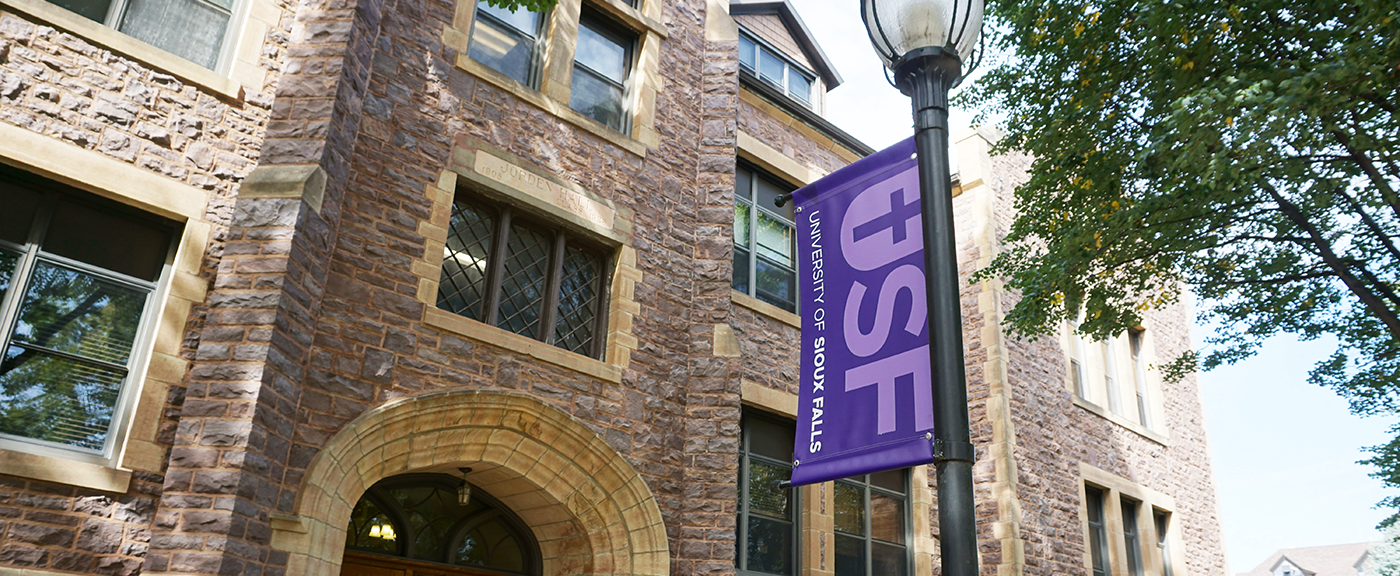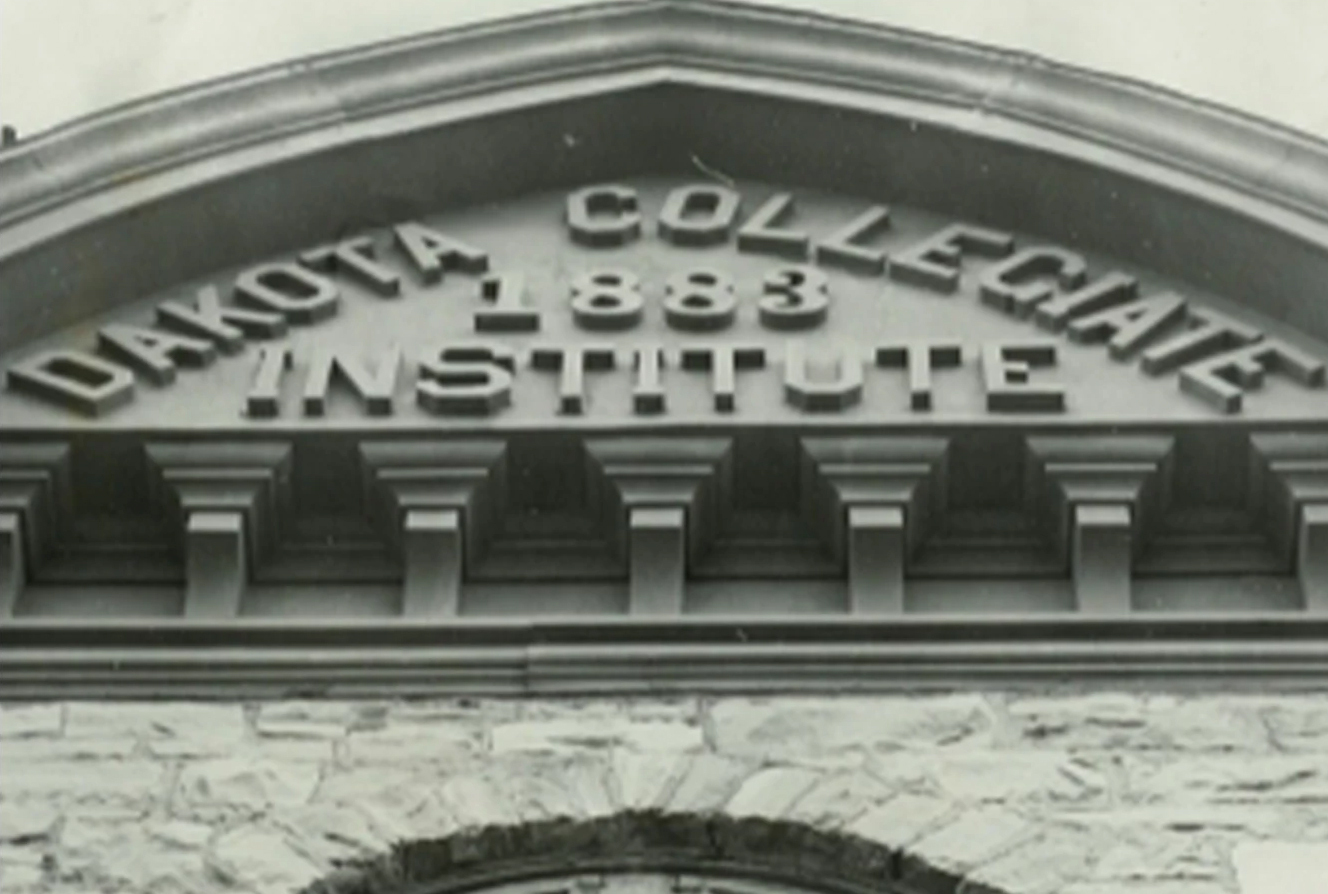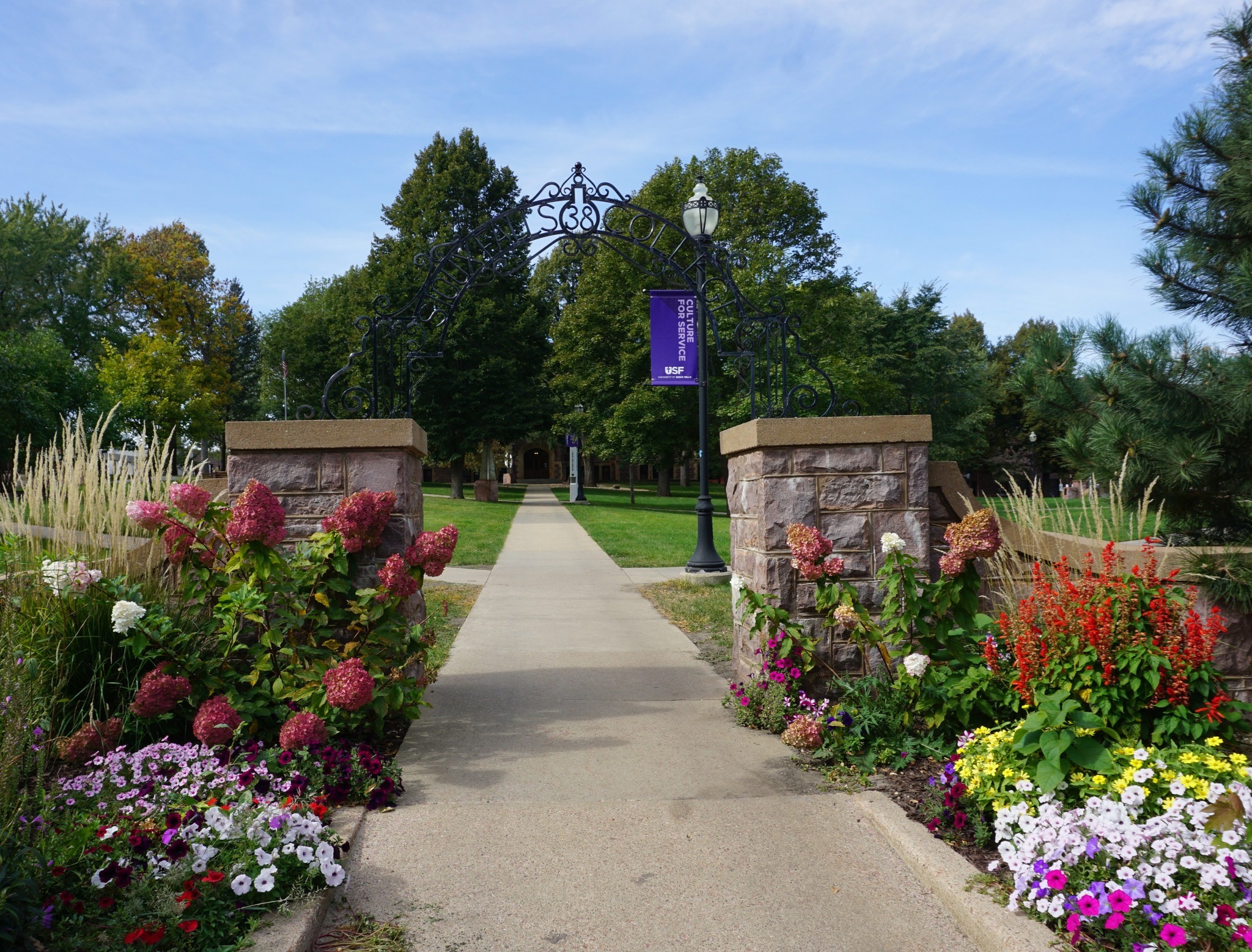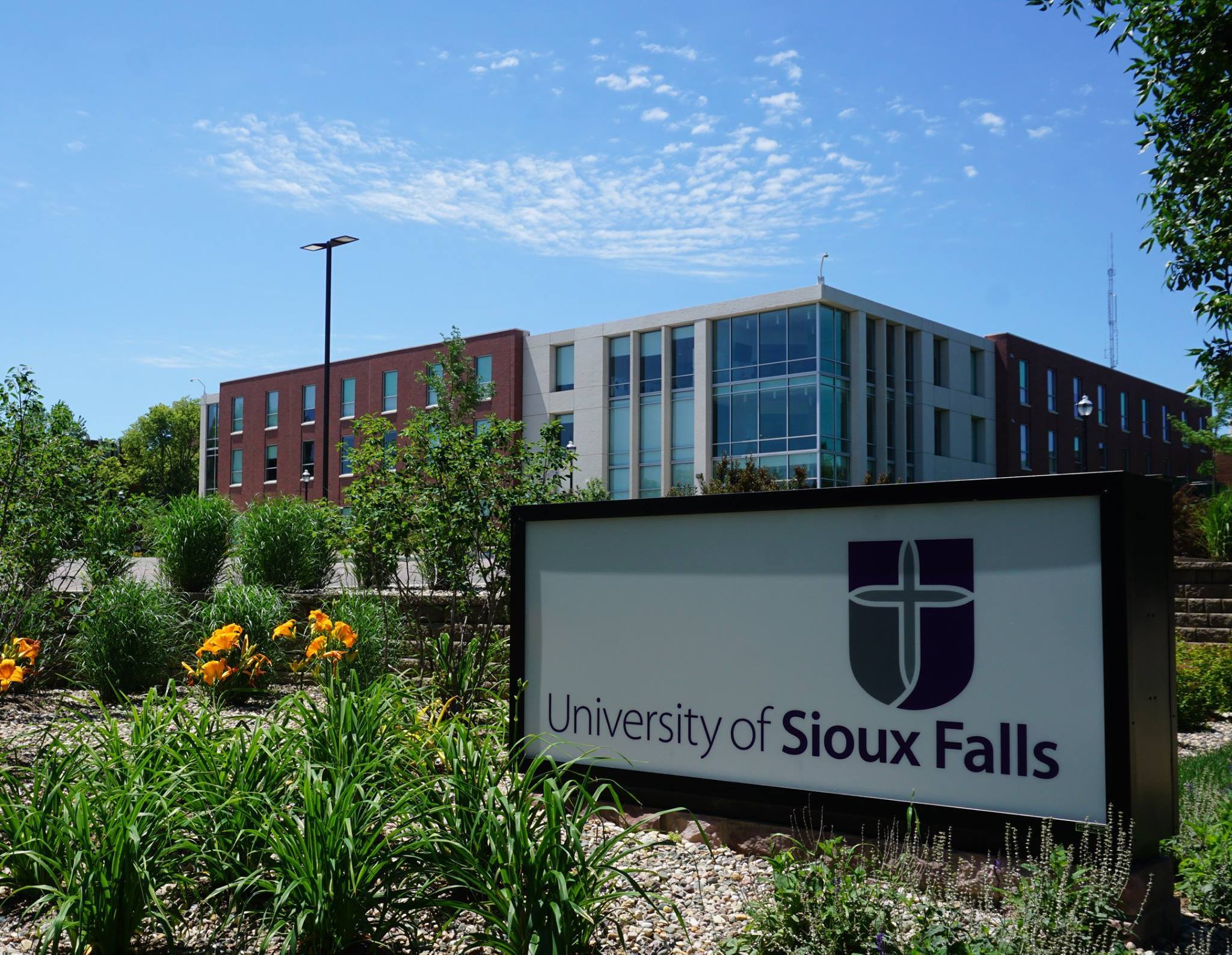| 1872 | First resolution of Baptist Association is adopted, providing for "...more general and complete education of our youth under distinctively Christian influence." |
| 1883 | Under the name Dakota Collegiate Institute, secondary and collegiate programs begin in the basement of the Sioux Falls First Baptist Church. Campus site is selected along the Old Yankton Trail. |
| 1885 | Name changes to Sioux Falls University. Evan B. Meredith is 1st president. Dakota Hall (renamed Meredith Hall in 1929), the campus' first building, is built for $16,000. |
| 1890 | Student newspaper, The Stylus, reports, "The football team will be ready to begin work as soon as they get a ball." |
| 1895 | Edward B. McKay is 2nd president. |
| 1897 | Alfred B. Price is 3rd president. |
| 1898 | A. Wellington Norton is 4th president. |
| 1900 | Tuition is $9.00 per semester. |
| 1903 | Alfred J. Finch is 5th president. |
| 1904 | Pearl Irene Odell is the first four-year college graduate, earning a Bachelor of Arts degree. Edward F. Jorden is 6th president. |
| 1908 | 25th anniversary is celebrated. Jorden Hall is built. First glee clubs for men and women are established. |
| 1910 | First Student Association is formed and includes: athletics, debate, oratory and student newspaper. |
| 1915 | Rolvix Harlan is 7th president. |
| 1916 | First major fundraising effort to include Sioux Falls is launched. The city ends up donating $50,000. |
| 1918 | Donald F. Charles is 8th president. |
| 1918 | Female students petition for a credit course in physical training, and by 1923 the physical education department is established. |
| 1920 | V.C. Coulter is 9th president. |
| 1921 | First homecoming, called Bum Days, is held. |
| 1922 | Fred G. Boughton is 10th president. Second homecoming, called Soo Boo Day, is held. |
| 1923 | Purple Feather Award tradition begins. In the fall of 1923, a contest is held and the name 'Sioux Braves' is selected as the name for the athletic teams. Homecoming tradition of Teepee Day begins. Professors Max Martini and Laurence Nelson want to preserve the history of the campus' land that was once inhabited by the Sioux and other Native American tribes. The Teepee Day tradition will continue for 53 years. Pierce Gym (now Pierce Hall) is built, allowing basketball to move out of the chapel. Although dances are not allowed on campus, roller skating in Pierce Gym is a popular form of entertainment. |
| 1925 | Academy for secondary education closes. |
| 1926 | Joseph A. Cooper is 11th president. |
| 1929 | Des Moines University of Iowa closes and its records are transferred to Sioux Falls University. Glidden-Martin Memorial Hall is built. |
| 1930 | Charles R. Sattgast is 12th president. Cedar Valley Seminary of Iowa closes and its records are transferred to Sioux Falls University. |
| 1931 | Parker College of Winnebago, Minn., closes and its records are transferred to Sioux Falls University. Grand Island College of Nebraska merges with Sioux Falls University and forms a new corporation, Sioux Falls College. SFC receives North Central Association of Colleges (NCAC) accreditation as a two-year college. |
| 1933 | 50th anniversary is celebrated. American Baptist State Conventions of North and South Dakota, Iowa, Nebraska and Minnesota pass a resolution officially recognizing the college as a denominational institution. SFC receives full, four-year college-status accreditation by the NCAC. |
| 1937 | Warren P. Behan is 13th president. Due to drought and depression, SFC drops to junior college status. |
| 1941 | Barret Lowe is 14th president. |
| 1943 | John L. Barton is 15th president. |
| 1944 | Ernest E. Smith is 16th president. |
| 1947 | An old army barracks is attained from the Sioux Falls air base and is used to house 40 male students. |
| 1948 | Another army barracks is secured and used as a chapel. It is named Memorial Chapel in honor of the 273 alumni who fought in WWII, in particular the 16 who lost their lives. |
| 1950 | Evan A. Reiff is 17th president. |
| 1953 | After the football team lost 28 consecutive games in four years, Coach Phillip Tinsworth vowed that he would stand on his head at the corner of 10th and Phillips Avenue if his team won a game. Finally, on Teepee Day in 1953, the Braves beat the Trojans of General Beadle College (now Dakota State) 13-0, and Coach Tinsworth kept his promise. In December 1953, Dr. Reuben Jeschke, who was currently dean and interim president, became the 18th president of SFC. By January 1954, the campaign goal to raise $200,000, liquidate all debt and balance the budget was accomplished, and an era of growth and prosperity began. |
| 1958 | 75th anniversary is celebrated. Full, four-year accreditation is regained, granted by the NCAC. |
| 1959 | John W. Kroske Hall is built. |
| 1963 | Grand Island Hall is built. Salsbury Student Union is built. |
| 1963 | First Madrigal Dinner is held with Dr. and Mrs. Reuben Jeschke serving as Lord and Lady. |
| 1965 | Norman B. Mears Library is built. SFC singing group performs at the World's Fair. |
| 1966 | Warren W. Burgess Residence for Men is built. First of many European tours for SFC music groups takes place. |
| 1967 | Joseph E. Salsbury Science Center is built. Sioux Falls College is featured in Time magazine. The caption reads: "Seven Buildings in Seven Years." The subtitle adds: "But our stature comes from people." The value of the campus increases from $580,000 in 1953 to $5.5 million by 1970. |
| 1970 | Ronald V. Wells is 19th president. |
| 1971 | Reuben P. Jeschke Fine Arts Center is built and is (at that time) the largest auditorium in South Dakota. |
| 1974 | Owen P. Halleen is 20th president. |
| 1978 | Patterson Hall is built. |
| 1979 | Braves mascot is changed to Cougars. |
| 1980 | Masters in Education program begins. |
| 1987 | Degree Completion Program is established for working adults who want to complete their college degrees. |
| 1988 | Thomas F. Johnson is 21st president. |
| 1993 | Masters in Business Administration program begins. |
| 1995 | Sioux Falls College becomes the University of Sioux Falls. |
| 1996 | USF Cougars win NAIA National Football Championship. |
| 1997 | Mark S. Benedetto is 22nd president. |
| 2000 | Tuition is $6,050 per semester. |
| 2001 | Cleveland Professional Development Center is built. Mary Collier Baker Hall is built. |
| 2002 | USF Foundation is established with the mission to secure the University's future. |
| 2005 | Bill & Marian Sullivan Faith & Living Center is built. |
| 2006 | USF Cougars win NAIA National Football Championship. |
| 2007 | McDonald Center is built. USF Sports Complex is built, where Cougars play. USF Sports Complex is built, where Cougars play first home football game at Bob Young Field. |
| 2008 | 125th anniversary is celebrated. |
| 2009 | USF School of Nursing founded. |
| 2011 | USF SculptureWalk dedicated. |
| 2012 | USF became an official member of the NCAA D-II. |
| 2013 | Largest graduating class in the University's history. Graduated the first class of traditional four year track Bachelor of Science in Nursing students. |
| 2014 | Officially named property at 69th Street and Cliff Avenue USF South Campus. |
| 2016 | North Residence Hall construction begins. |
| 2017 | Dr. Brett Bradfield named 23rd president. |
| 2022 | Visual rebrand is completed. |









